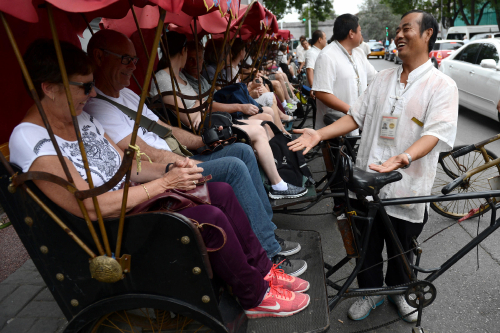 |
|
WELCOME TO CHINA: A rickshaw driver in Beijing's Shichahai area chats with foreign tourists on September 14 (ZHANG RUI) |
Though there has been vigorous growth in outbound tourism and with it a generous increase in Chinese money being sent overseas, the same cannot be said of China's inbound tourism industry. According to the China Tourism Academy (CTA), a research institute under the China National Tourism Administration (CNTA), there will be a $100 billion tourism deficit this year.
In 2014, about 116 million Chinese citizens are expected to travel overseas, and spend a total of $155 billion, up 20 percent from a year ago, said Dai Bin, President of the CTA.
China saw fewer foreign tourists in 2008, when the global financial crisis led to drastically reduced foreign tourist spending in the country while a stronger yuan encouraged tourist outflow, according to Xinhua News Agency.
Explosive outbound travel
China is the world's largest source country for outbound tourists and ranks first in international tourism expenditure, according to CTA's annual report released on June 10. The report reviewed the development of China's outbound tourism in the year 2013.
When analyzing inbound and outbound tourism, we should distinguish between foreign visitors and visitors from Hong Kong, Macao and Taiwan, said Zhang Weiqiang, a professor with the Guangdong University of Finance and Economics (GUFE). Currently, visitors from Hong Kong, Macao and Taiwan to China's mainland are counted as inbound tourists, and vice versa.
In 2013, Chinese travelers made 98.19 million international trips, up 18 percent from 2012, according to the CTA report, making for a 10-fold increase since 2000 when compared to data from the UN World Tourism Organization.
The CTA report revealed that Chinese tourists spent a total of $128.7 billion overseas in 2013, up 26.8 percent from the previous year, when the country overtook Germany as the top international tourism spender.
CNTA estimated that in the first half of 2014, Chinese travelers spent more than $70 billion on their overseas trips, up 20.7 percent year on year.
Appreciations of the Chinese yuan, relaxed visa policies and domestic policies encouraging the orderly development of tourism have contributed to the growth of outbound tourism, the report said.
As the leader of a think tank in the tourism industry, CTA President Dai said that he has personally witnessed this dramatic growth in outbound tourism.
"Seven or eight years ago, we were often woken up from our sleep by phone calls from friends sending greetings from the Statue of Liberty, the Sphinx statue in Egypt, Notre Dame in Paris or the Sydney Opera House," Dai said. He went on to explain that they called because they were very excited to get abroad. Now, this no longer happens because traveling overseas is not such a rare thing, he said.
Now it's not only officials and celebrities traveling overseas, but also the general public, Dai said, adding that this has become part of the middle class lifestyle.
This year, Wang Qing and his wife, a retired couple in Beijing, made two overseas trips. They first went sightseeing in Europe with a tour group in the spring, and finding traveling overseas to be quite exciting, they then went to Thailand.
Outbound tourists used to almost all come from first-tier cities such as Beijing, Shanghai, Guangzhou and Shenzhen, and other economically developed coastal cities. Now more and more of them are from second and third-tier cities and central and western China, Dai said.
Tourists are no longer content with following tour groups, either; many have begun to choose individualized travel packages and a more in-depth experience of their destinations.
The most frequently visited destination region for outbound Chinese travelers in 2013 was Southeast Asia, where around 10 million Chinese traveled, said Dai. That year, more than two thirds of outbound tourists visited Hong Kong, Macao and Taiwan, and just over 30 million traveled to foreign countries, he said.
| 